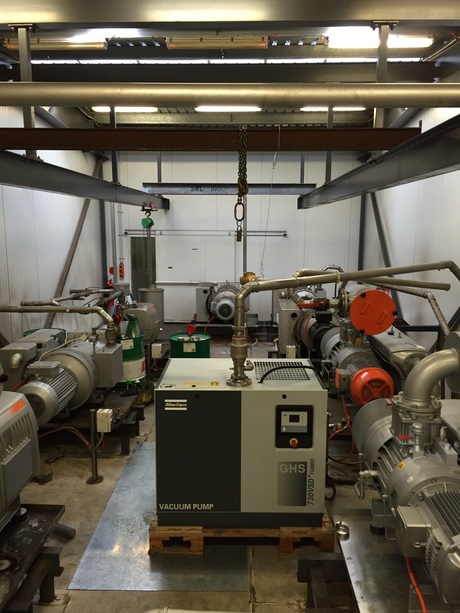Major production changes set for meat processors

A number of successful trials using rotary screw vacuum pumps instead of rotary vane pumps in operating industry-standard rotary vacuum packaging machines is set to have a major impact on the meat processing industry.
Until now, energy consumption for vacuum pumps in the meat processing industry was never considered that seriously.
The usual practice is to start the vacuum pumps in the morning and turn them off at the end of the shift. They run for the full duration of the shift unless the operator is conscientious and shuts them down during breaks. However, this is about to change as Atlas Copco’s GHS VSD+ rotary screw vacuum pump offers savings for these particular scenarios.
The trials, held recently at two of Australia’s leading meat processing plants in Queensland, clearly showed that Atlas Copco’s rotary screw technology is far superior to the rotary vane technology presently used in the industry, in both energy efficiency and maintenance costs.
Atlas Copco Regional Business Line Manager – Utility Vacuum Pierre Matschke explained that the first trial involved replacing a 22 kW rotary vane vacuum pump with a 15 kW rotary screw vacuum pump on the second stage of one of the meat processor’s vacuum packaging machines.
“The trial showed that our rotary screw vacuum pump, which has now been running reliably for six months, is far superior in life cycle costs to the traditional rotary vane vacuum pump.
“While the customer was very pleased with the +17% energy saving the machine was achieving, it was when we looked at the customer’s maintenance costs we realised our machine was able to make even larger savings by reducing their maintenance costs drastically.”
The most recent trial achieved even better results, which involved replacing two 22 kW rotary vane vacuum pumps with just one 37 kW rotary screw vacuum pump, and one for one 15 kW on the second stage.
Matschke said the customer was very impressed with the GHSVSD+’s reaction time and the major savings he is achieving on both energy and maintenance costs.
“As well, the performance of the packaging machine has improved. With the rotary vane vacuum pumps, the packaging machine used to run at only 2 mbar, as that was the lowest vacuum they could achieve on most days, but with our rotary screw vacuum pumps the vacuum is consistently down to ‘0’ mbar.
“And with less air in the pack, the meat stays fresher with a longer shelf life; a major benefit for the meat processor, supermarkets and consumers.”
Matschke admits it was a struggle at first to convince companies of the exceptional benefits of investing in rotary screw machines but following the outstanding results from the trial sites, he said companies are now preparing to make the switch.
“And not just energy savings, due to the rotary screw machine’s proven technology, customers’ maintenance costs are drastically reduced.”
Atlas Copco has been successfully using the same screw technology worldwide in its air compressors since the late 1960s, with just minor machining differences to accommodate oil flow in vacuum applications.
Unlike rotary vane pumps, where the vanes are in constant contact with the stator and wear over time, the rotary screw pumps have no surface contact or wearing parts in the compression chamber.
This constant contact, and extra load at start-up, means the vanes need replacing every 16,000 running hours (three to four years on average) and, depending on the machining required, overhauls can cost anywhere between $12,000 to $20,000, which often leads to a complete pump replacement after just three to four overhauls.
Matschke pointed out that extending the overhaul intervals is not a viable option as it only causes more extensive damage to the pump, with overhauls costing even more, plus pump energy consumption increases by around 16% per year due to wear, adding an average of $5300 over five years in energy costs alone. Customers also start to see pack quality reducing.
However, with the rotary screw vacuum pumps, overhaul intervals are only after 48,000 running hours (11–12 years) and cost less than half that of rotary vane. And with the extended intervals of the GHSVSD+, users can experience a reduction in overhaul costs of ±89% over 10 years.
Also, no machining is required (re-bearing only) plus the pumps’ efficiencies remain constant throughout the life of the units and are not affected by start-up, with the VSD (variable speed drive) offering unlimited starts.
Investing in rotary screw pump technology also offers major savings on expensive exhaust filters (around $200 each). Due to a multifunction inlet valve, which reduces the mass flow onto the filters, the rotary screw vacuum pump set only requires 18 filters as opposed to 48 on the vane pump set.
Matschke said all these savings mean the ROI on a rotary screw vacuum pump can be as low as 1.3 years, depending on the number of overhauls due on existing vane pumps, and lead to total cost of ownership savings of over $170,000 over five years on just one packaging machine alone.
“We are also working closely with our customers to generate even more savings such as optimising piping and integrating the controls so that when the packaging machine slows or stops so do our machines, saving even more energy.”
Wineries get smart with sensors to prevent overspill
When every drop of wine counts, innovative tech solutions are available to help wineries protect...
Making sweet and salted popcorn with no changeovers
A popcorn manufacturer wanted to achieve three things from its new line: pack small 11 g bags at...
Whey more unified at greenfield cheese plant
A large cheese manufacturer has ramped up production at its large-scale greenfield plant with...














